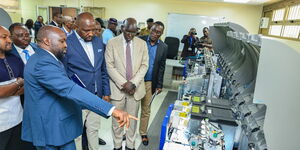Parts of Kenya and the larger Eastern African region could split from the continent, potentially forming a new island, according to a new study.
The findings follow a study by a team of international scientists, led by Prof Fin Stuart of the University of Glasgow, who analysed volcanic gases from the Menengai geothermal field in Kenya’s Rift Valley, after which they made the conclusion.
According to the study, published on Forbes, the chemical analysis provided the first evidence of a superplume beneath East Africa — a massive column of hot rock from deep within the Earth that is driving tectonic activity and gradually pulling apart the Somali plate and the Horn of Africa from the rest of the continent.
The scientists warn that this ongoing tectonic activity could eventually cause the Somali plate and parts of East Africa, including parts of Kenya, to split from the rest of continent, raising the possibility of the formation of a new island.
The study could be aided by the recent cracks that have emerged along roads and regions within the Rift Valley which are manifestation of the African tectonic plate being split apart, driven by forces in the Earth’s interior.
The rift valleys extend for 3,500 kilometers through Ethiopia, Kenya, Uganda, and Malawi, and host extensive volcanic fields.
According to the scientists, there exists a layer reffered to as 'superplume' beneath East Africa that is driving active tectonics that are gradually pulling parts of Kenya and the broader East African region apart.
This process can eventually cause sections of land to split away, potentially leading to the formation of new islands as parts of the continent slowly separate.
The plume not only drives the tectonic plates apart, but also pushes up the African continent preventing the rift zone to be flooded by the Red Sea (forming the geologically spectacular landscapes of the Afar Depression).
However, scientists are uncertain whether the volcanism and rifting is due to shallow processes or whether it is driven by up-welling hot material from Earth’s mantle.
The researchers used gases collected from the Menengai geothermal field (started in 2009 and still in development) in central Kenya to reconstruct the source in Earth’s mantle feeding the geothermal activity.
Meanwhile, in what might be good news, oil drillers say the area also holds a string of fields that could make Kenya a major energy producer from the oil barrels.












